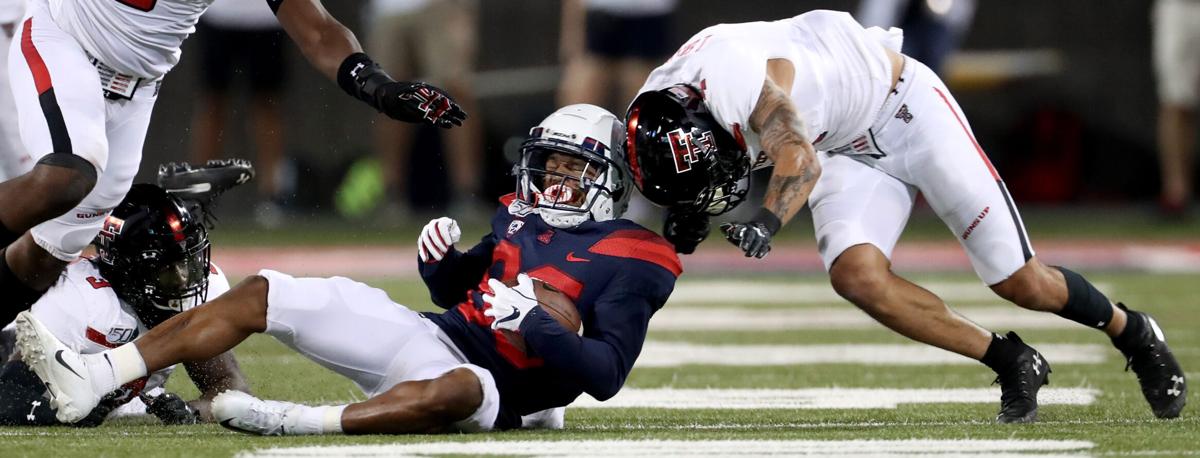The most controversial, frustrating and infuriating penalty in college football will remain in place for the foreseeable future, and the industry has the Pac-12 to thank for it — seriously.
Someone had to collect the data, draw the conclusions and lend legitimacy to the one penalty — targeting — that might help save the sport.
Because you know what’s worse than the targeting penalty? Concussions, chronic traumatic encephalopathy (CTE) and the long-term impact of serious brain injury.
And you know what’s bad for the health of college football? The stigma of head trauma, uncaring coaches and administrators, and dwindling participation numbers — especially on the West Coast.
The targeting penalty — in both college and the NFL — was designed to reduce blows to the head, thereby limiting instances of concussions and making the sport safer.
Has it worked?
A multi-year Pac-12 study set out to determine if targeting plays “are higher risk for concussion than other plays in American football.”
The connection is clear: Concussion risk was 39 times higher during targeting plays than during all other plays.
“The Pac-12 has been looking at this stuff for years,” said Utah athletic director Mark Harlan, who serves on the influential NCAA Football Oversight Committee and chairs the sub-committee on practice and playing.
“You look at the overall data, and it appears to have altered the game in a positive way.”
The targeting rule isn’t perfect — players have been wrongfully ejected. But the enforcement process has become more efficient and accurate over the years. In fact, the NCAA tweaked the process this spring, allowing teams to appeal suspensions in certain situations.
But the rule itself will remain in place, entrenched as ever following the results of the Pac-12 study.
“There has been a lot of discussion and debate about targeting and whether it’s called too frequently, so we wanted to look at the data,” said Dr. Doug Aukerman of Oregon State, one of the study’s authors.
“There was an increased relative risk of concussion diagnosis whether targeting was upheld or overturned.”
Conducted by 10 doctors and researchers affiliated with the conference, the study examined 538 Pac-12 games over a four-year period (2016-19).
The schools provided injury information so instances of concussion could be identified in the plays under review. The researchers filtered for plays in which targeting was called.
According to the study, which was published by the National Library of Medicine:
68,670 plays were reviewed, during which 213 concussions occurred (15 during plays where targeting was called and 198 on other plays)
The incidence of concussion was 106.4/1000 plays for targeting plays and 2.9/1000 plays for non-targeting plays.
The risk of concussion during targeting plays was 36.9 times greater than that for all other plays.
The risk of concussion during targeting plays upheld was 49.0 times greater than that for all other plays.
“The targeting penalty, whether it meets the criteria or not, just the fact that the official threw the flag means it’s significant and the participants should be checked to make sure they’re OK,” Aukerman said.
The penalty itself, the frequency of concussions, the study and conclusions — it’s all significant when cast against one of the most serious threats to the long-term health of college football on the West Coast.
The Pac-12’s talent pipeline is drying up, folks, and it’s drying up faster than those in other Power Five leagues.
According to data published by the National Federation of State High School Associations, prep football participation in California dropped by 11.7% over a five-year stretch prior to the pandemic (2014-18).
The decline was comparable in Arizona (11%) and even worse in Oregon (14%).
Meanwhile, participation in Georgia fell by 3.2% over the five-year span, while Florida saw a decline of just 0.6%. In Texas, high school football participation increased.
The Pac-12 has exposure and revenue problems that it hopes to rectify with a new media rights agreement in 2024.
It has a competitive problem that should be solved (mostly or partially) by College Football Playoff expansion in 2026.
But it has a participation problem that could continue unabated unless high school players and their parents across the conference footprint believe the game is being made safer.
“The more information we can get to the public,” Aukerman said, “and the more engaged health professionals can be in helping shape and evaluate the rules to create safer environment for a wonderful sport — hopefully, that will be reassuring that there are ways to play the game to mitigate risk.”





